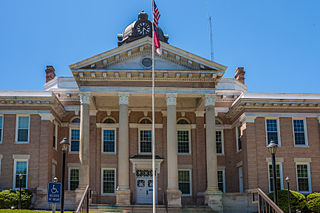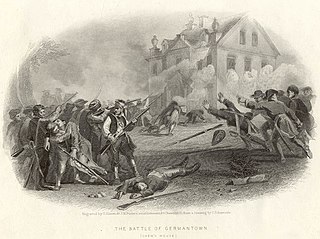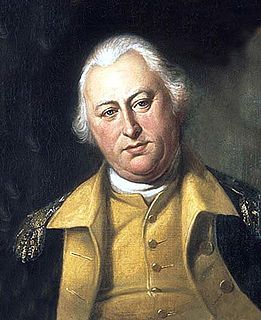The 3rd Continental Light Dragoons, also known as Baylor's Horse or Lady Washington's Horse, was a mounted regiment of the Continental Army raised on January 1, 1777, at Morristown, New Jersey. The regiment saw action at the Battle of Brandywine, Battle of Germantown and the Battle of Guilford Court House.
The 1st North Carolina Regiment of the Continental Army was raised on September 1, 1775, at Wilmington, North Carolina. In January 1776 the organization contained eight companies. Francis Nash was appointed colonel in April 1776. The regiment was present at the defense of Charleston in 1776. It transferred from the Southern Department to George Washington's main army in February of 1777. At that time, Thomas Clark became colonel of the 1st Regiment. The unit became part of Nash's North Carolina Brigade in July.
The 3rd North Carolina Regiment was raised on 16 January 1776 at Wilmington, North Carolina for service with the Continental Army. In April, Jethro Sumner was appointed colonel. The regiment was present at the defense of Charleston in June 1776. The 3rd Regiment transferred from the Southern Department to George Washington's main army in February 1777. Assigned to Francis Nash's North Carolina Brigade in July 1777, it soon saw action at the battles of Brandywine and Germantown, and was present at White Marsh. Sumner went home ill in early 1778. Together with the 4th, 5th, and 6th North Carolina Regiments, the 3rd Regiment was reduced to a cadre and sent home to recruit up to strength on 1 June 1778. The rebuilt regiment returned to the main army in late 1778, but it was reduced to a cadre again in April 1779 and sent back to its home state. Assigned to the North Carolina Brigade, the regiment fought at the Siege of Charleston where it was captured by the British Army on 12 May 1780. The regiment was officially disbanded on 15 November 1783.
The 5th North Carolina Regiment was assigned on March 26, 1776, to the Continental Army in the Southern Department. It was organized in the spring of 1776 at Wilmington, North Carolina, as eight companies of volunteers from the districts of New Bern, Edenton and Hillsborough of the colony of North Carolina. On 5 February 1777, the regiment was assigned to the main Continental Army and assigned to the North Carolina Brigade on 8 July 1777. The regiment was reduced to a cadre on 1 June 1778 at Valley Forge, Pennsylvania and was assigned to the Southern Department. The regiment was re-organized to nine companies during the fall of 1778 at Halifax and assigned on 11 January 1779 to Sumner's Brigade. On 3 June 1779, this brigade was redesignated as Armstrong's Brigade. The regiment was captured by the British Army on 12 May 1780 at Charlestown, South Carolina and was officially disbanded on 1 January 1781.
The 8th North Carolina Regiment was authorized on November 26, 1776 and assigned to the Southern Department of the Continental Army. The unit saw action at the Battle of Brandywine and Battle of Germantown during the American Revolution. The Regiment was commanded by Colonel James Armstrong. The regiment was disbanded on 1 June 1778 at Valley Forge, Pennsylvania.
The 4th South Carolina Regiment was raised on November 13, 1775, at Charleston, South Carolina, for service with the South Carolina Troops and later became part of Continental Army.
The 6th South Carolina Regiment was authorized on 28 February 1776 in the South Carolina State Troops and was organized during the spring of 1776 as five companies of volunteers from the northwestern region of the colony of South Carolina. It may have been composed exclusively of expert riflemen from the colony.

The North Carolina Line refers to North Carolina units within the Continental Army. The term "North Carolina Line" referred to the quota of infantry regiments assigned to North Carolina at various times by the Continental Congress. These, together with similar contingents from the other twelve states, formed the Continental Line. The concept was particularly important in relation to the promotion of commissioned officers. Officers of the Continental Army below the rank of brigadier general were ordinarily ineligible for promotion except in the line of their own state.
The Hillsborough District Brigade of militia was an administrative division of the North Carolina militia established on May 4, 1776. Brigadier General Thomas Person was the first commander. Companies from the eight regiments of the brigade were engaged in 55 known battles and skirmishes in North Carolina, South Carolina, and Georgia during the American Revolutionary War. It was active until the end of the war.

The Maryland and Virginia Rifle Regiment, most commonly known as Rawlings' Regiment in period documents, was organized in June 1776 as a specialized light infantry unit of riflemen in the Continental Army during the American Revolutionary War. The American rifle units complemented the predominant, musket-equipped, line infantry forces of the war with their long-range marksmanship capability and were typically deployed with the line infantry as forward skirmishers and flanking elements. Scouting, escort, and outpost duties were also routine. The rifle units' battle formation was not nearly as structured as that of the line infantry units, which employed short-range massed firing in ordered linear formations. The riflemen could therefore respond with more adaptability to changing battle conditions.
Pinketham "Pink" Eaton of North Carolina was a distinguished American officer in the Continental Army during the American Revolutionary War. He was the uncle of John H. Eaton, who served as a United States Senator from Tennessee and Secretary of War.
The Mecklenburg County Regiment was authorized on May 31, 1775 by the Province of North Carolina Congress. From November 7, 1779 until the 3rd Quarter of 1780, it was called the 1st Mecklenburg County Regiment when a 2nd Mecklenburg County Regiment existed. The 1st Mecklenburg County regiment was engaged in 39 known battles and skirmishes against the British during the American Revolution in North Carolina, South Carolina and Georgia between 1776 and 1781. It was active until the end of the war.
The Edenton District Brigade was an administrative division of the North Carolina militia during the American Revolutionary War (1776–1783). This unit was established by the North Carolina Provincial Congress on May 4, 1776, and disbanded at the end of the war.
The Wilmington District Brigade was an administrative division of the North Carolina militia during the American Revolutionary War (1776–1783). This unit was established by the North Carolina Provincial Congress on May 4, 1776, and disbanded at the end of the war.
North Carolina state troops in the American Revolution were the initial military units created in a transition from the Province of North Carolina under British rule to independence from British rule. Most units did not last long as such and were either transferred to the Continental Army or state militia instead.
William Caswell was a general in North Carolina militia in the American Revolution, Dobbs County, North Carolina county official, North Carolina state legislator, and planter.








